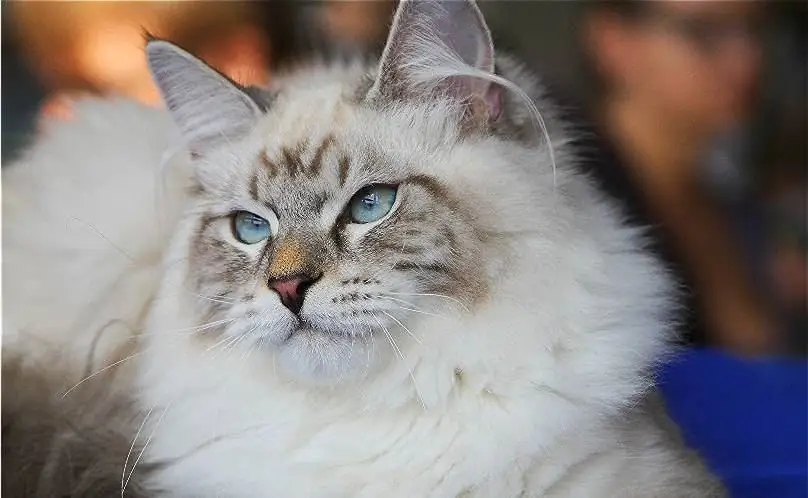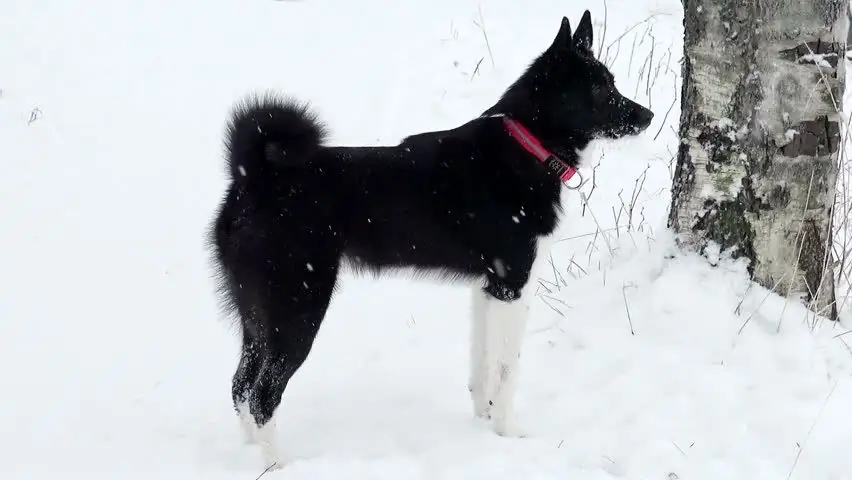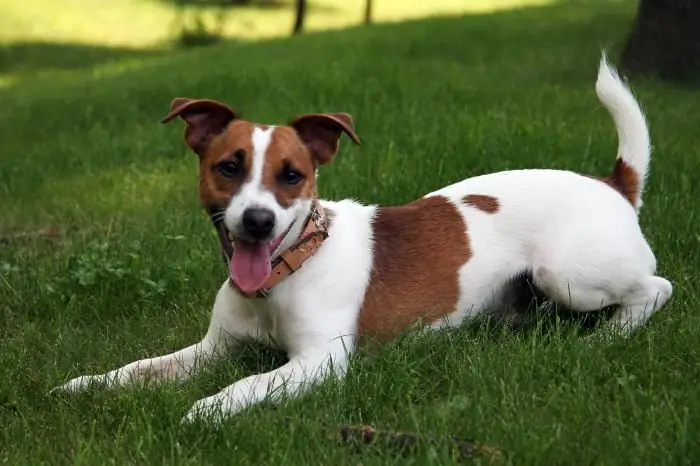2026 Author: Priscilla Miln | [email protected]. Last modified: 2025-06-01 05:14:29
Russia has always loved hunting. The vast expanses of the country and the countless variety of game contributed to the increase in the army of hunters. Dogs were used for successful fishing. Russian breeders sought to develop a breed adapted to local conditions. The result of their work was the Russian piebald hound. Today, dogs of this breed are among the most popular and in demand in the former Soviet republics.

Origin
The first mention of Russian hounds can be found in the annals of the eleventh century. Dog hunting has always been a popular pastime for the Russian nobility. In the 18th and 19th centuries, we althy owners could afford to keep up to several hundred animals. Naturally, everyone tried to improve their livestock. For these purposes, they used English foxhounds imported from Europe, which were considered one of the best hunting breeds. Later, French-bred dogs were used.
Unsystematic crossing led to the appearance of different types of animals. Russian hounds were called dogs similar in working qualities, but completely different in appearance. They stood out for their excellent stamina and peculiar sonorous barking. Through the efforts of breeders, by the end of the 19th century, the livestock was stabilized, and in 1895 the breed standard was adopted.
Dogs were bred in several breeding plants. The work was interrupted for the period of the civil war in Russia. After its completion, breeding was resumed. During this time, most of the livestock was lost, but the breeders managed to restore it. In 1925, at the 1st All-Union Cynological Congress, the breed standard for the Anglo-Russian Hound was adopted. Subsequent breeding was carried out "in itself", the admixture of foreign blood was not allowed. The selection was carried out not only for working qualities, but also for the ability of animals to adapt to local conditions.
The Russian Pinto Hound (the photo is presented in this material) received its official name in 1951, by which time the breed standard had changed somewhat. The breed is distinguished by a pronounced appearance, a certain character and excellent working qualities. Despite the numerous livestock and fruitful use of dogs for hunting, the FCI has not yet recognized the breed.

Description of the Russian Pinto Hound
- Appearance. Strong, beautiful, proportionally folded dog. The muscles are well developed, the skeleton is massive. Looks like a foxhound.
- Working qualities. doghas a subtle scent. It helps the animal to easily navigate and confidently follow the trail. A strong sonorous voice can be heard far in the forest, according to which the hunter confidently goes to the game. The fearlessness of dogs helps them follow the trail of large animals, a wolf or a bear.
- Character. Friendly, kind, smart. Russian piebald hounds work well both alone and in pairs. Peaceful in the flock. Obedient, easy to train, loyal to the owner.
- Suit. The vast majority of the breed is white with red and black markings. There is a black, crimson with markings color or gray and tan.
Standard
The Presidium of the Russian Federation of Hunting Dog Breeding in 1994 approved the breed standard for the Russian Pinto Hound. Standard Description:
- Head. Not heavy, has a clear outline, well covered with leather. The forehead is narrow and flat, the occiput is moderately developed. The neck is muscular, rounded, equal in length to the head.
- Eyes. They are oval in shape, large, widely set, expressive, intelligent. The standard allows a slight slant. The color is brown, rich dark tones are welcome. Dark eyelids.
- Muzzle. Wedge-shaped, rounded lower jaw. Lips close fitting, not pendulous. The bottom is slightly thicker than the top. Cheeks and cheekbones are flat. The nose is black, large.
- Teeth. White, covered with snow-white strong enamel. Scissor bite, correct, without gaps.
- Ears. Medium size, thin, triangular shape, rounded tips. Set high, hanging, tightclose to the head, down to the cheeks. Creases are allowed.
- Torso. The body is rectangular. Strong bones, muscles are well developed, embossed. The withers are massive, better expressed in males.
- Chest. Deep, descends to the elbow joints, the ribs are rounded, springy, wide. Belly toned.
- Back. Strong, wide. The loin is rounded, well defined. The croup is sloping, powerful.

- Limbs. Straight, high, with well-defined muscles, widely set, dry and strong. The shoulders are well developed, the forearms are oval and strong. The joints are large. The hind limbs noticeably go beyond the line of the croup, they are strong, the thighs are elongated, the metatarsus is sheer. The paws are oval or round in shape, the toes are tightly clenched.
- Tail. Thick at the base, tapering towards the end, saber-shaped, raised upwards. Buying is not accepted.
- Wool. The outer hair is hard. The undercoat is well developed, but not too dense, does not repel water and dirt. On the ears, legs and head, the hair is shorter than on the rest of the body (4-5 cm, even longer on the hips). The skin does not form wrinkles.
- Suit. Three color options are allowed: gray-piebald, crimson-piebald; tricolor - a combination of piebald and black color. The spots can be of any size and cover any area, the belly and paws are always white. Small mottling allowed.
Height and weight are not specified in the standard. The weight of animals ranges from 25-30 kg, females are 55-65 cm tall, and males are 58-68 cm tall. The average life expectancy is 12 years.
Character traits
The Russian Pinto Hound breed has a calm and balanced character. Its representatives quite calmly get along with other dogs, they can be "friends" with cats. However, birds and small rodents remain an object of hunting for them. The peculiarity of the breed is the ability to work both in a pack and alone.
Do not show importunity, demanding attention from the owner. They get along well with children, but a small child is unlikely to keep an energetic friend on a leash. By nature, animals are curious and rather arrogant. They will not beg for something tasty - they will take it themselves. Moreover, they demonstrate miracles of ingenuity. Re-educating is a waste of time, it is easier to securely close and hide food.

Hounds have a poorly developed guarding instinct. They do not know how to take care of the owner's good, they will definitely bark at an outsider. By barking, the animal shows the full range of its emotions, and quite loudly. If you live in an apartment, this can be a problem.
Breed diseases
Dogs of the Russian Pinto Hound breed are distinguished by good he alth and strong immunity. However, there are a number of characteristic diseases:
- allergy, most often the result of an unbalanced or improper diet;
- hip dysplasia, usually congenital, diagnosed at one year of age;
- myositis, accompanied by inflammation (purulent, eosinophilic, rheumatic) of the muscles, leads to swelling of the muscle tissue, and then to chronic lameness;
- conjunctivitis, withthe advanced stage can become chronic;
- degenerative myelopathy (disease of the spinal cord), affects older animals, leading to paralysis of the hind limbs.
The dog is constantly in the forest, often in contact with wild animals, so timely vaccination and regular treatment against external parasites and worms is a prerequisite for maintaining the he alth of the pet.
Contents
The Russian piebald hound dog (the photo fully conveys its external characteristics) is an active and very mobile animal. The best place to live is a country house with a spacious open-air cage and a booth. The dog needs long walks and good exercise. It is recommended to walk on a leash, as a strong hunting instinct makes animals hunt "everything that moves." In the heat of chasing a cat or other dog, they may run away.
Wool does not require special care. During the molting period, the dog is combed out daily, the rest of the time - no more than once a week. Bathe animals as they get dirty. Hounds are naturally clean and don't get particularly dirty.

Feeding
Feeding the Russian Pinto Hound is no problem. A dog can digest food in about 8 hours. Usually, the daily portion is divided into several meals: 3 or 4. Such a diet will not cause an increased feeling of hunger in the animal. Serving size is determined by pet preference.
There are two options:
- Naturalfeeding. The basis of the diet is beef meat. Tubular bones (any animals and birds) are excluded. Vegetables, fruits, dairy products, offal, cereals are allowed.
- Feeding dry food. Balanced in all respects, the food will help to effortlessly maintain the good physical shape of the dog. When choosing a company, it should be taken into account that high-quality feed cannot be lower than the premium class.
It is strictly forbidden to feed animals from the table. As a treat, a sugar beef bone is quite suitable.
Training
The Russian Piebald Hound has an independent character and will try to prove its superiority. She immediately needs to be made clear who the "leader of the pack." Education begins from the moment when the puppy crosses the threshold of the house. At the age of 3 months, babies are taught the basic commands "Come to me", "Fu", "Sit", "No" and others. Later, "professional" teams come into play. Feeding is carried out only after the signal of the hunting horn. They practice walking young animals in the area of future hunting.
Beagles start to train at the age of 10-11 months, when the skeleton and muscle corset get stronger. You can’t rush to surge, you can harm the young body and vocal cords. The best time for surge is spring and autumn. By the beginning of the hunt, the dog must learn to walk near the owner without a leash, immediately leave the forest at the sound of a hunting horn. The innate mind and ingenuity of the hounds allows them to understand the owner perfectly.

Performance
For Russian Pinto dogsthe hound has qualities without which her work on the hunt is impossible:
- Flair. A well-developed flair helps to quickly find and pick up game. It will not allow the dog to lose track. This ability is inherited and highly valued by dog breeders.
- Productive. This is the ability to find and drive the beast, giving a voice. At the same time, the hound independently searches for game, adhering to the general direction of the hunter's movement.
- Voice. Informing, melodic, sonorous and strong. Helps the hunter determine the place to which the dog will drive the prey. The sign is transmitted from parents, when selecting pairs, the “vociferousness” of animals must be taken into account.
- Viscosity. The ability of an animal to persistently unravel a trail, and if it is lost, find it again and continue walking along it.
- Stamina. The rut of the beast can last for hours, a weak dog simply cannot withstand the load.
- Evil. Hounds have an innate malice towards the beast. They should not be afraid to drive a big game alone.
Hunting with a dog
Hound is an excellent hunting partner. Top Benefits:
- the dog will not only find the game, but also drive it to the shooter;
- will give time for aiming, not letting the hare get out from under the feet;
- a well-trained dog will bring game;
- losing the object of hunting with such a partner is almost impossible.
On the other hand, there are some difficulties. Not so often a modern person has time to break out on the hunt. Only a true professional can properly train a dog. A poorly trained hound will be more of a hindrance than a help. Not every game can be taken with a Russian piebald hound (photo "in work"). They mainly hunt hares, raccoon dogs, foxes, wolves, wild boars.
Choice
Russian Pinto Hound puppies are chosen when they are one month old. During this period, the defects of the animal are noticeable. Pay attention to the addition of the dog, its physical condition, activity. Size doesn't matter. Be sure to be interested in the origin of the puppy, working qualities are inherited.
The price range is large and depends on the class of the puppy:
- Pet class. Animals meet all the requirements of the breed, but have some flaws in appearance. They participate in exhibitions, they perform their hunting duties regularly. Price - $100 (5,600 rubles).
- Brid class. Puppies do not have serious shortcomings, but at exhibitions they rarely go to the winners. Working qualities correspond to the breed standard. Price 300-500 $ (16,900 - 28,000 rubles).
- Show class. The elite of the breed, they are purchased for breeding, 100% meet the requirements of the breed standard. Keeping these animals is expensive. Price from $1,000/56,000 RUB

It is not uncommon for hunters to prefer mature, well-trained dogs. Here the main difficulty is to establish contact with a partner.
Recommended:
Neva cat breed: photo and description, characteristics of the breed, reviews

Domestic cat lovers want certain qualities and mannerisms in their pets according to their preferences. Some owners are attracted to furry creatures by nobility and wit. Others like to play with animals, so they appreciate their playfulness and nimble character. There are also owners for whom the exterior of the purr, its attractiveness, is an important criterion when choosing. So, the Neva cat breed has collected many characteristic features inherent in such affectionate animals
Russian-European Laika: photo, characteristics and description of the breed, owner reviews

There are few hunting breeds of dogs that are suitable only for real Russian men, who are able to surf the taiga with a couple of crackers and a piece of lard in a bowler hat with a gun over their shoulders for days. And one of them is the Russian-European Laika. Not everyone has the patience to cope with her, but if someone has got such a dog, he will be in love with her all his life
Jack Russell Terrier: breed description, photo and character. Pros and Cons of the Jack Russell Terrier Breed

There is probably no more playful, active and interesting dog than the Jack Russell Terrier. This is exactly the funny shorty who tried on the green mask in the film of the same name with Jim Carrey. In its historical homeland, this breed is very popular, but it came to us not so long ago, but managed to become one of the favorite family dogs
Russian Shepherd Dog: description and features of the breed, photo

South Russian Shepherd Dog (also known as Ukrainian) looks very similar to a huge lap dog. The features of this breed are a little laziness (character trait) and long hair, which completely covers the muzzle. Even with such a characteristic, we can say that this dog is one of the most courageous and independent "bears", and this is not surprising, because it is intended for protection and shepherd service
Russian greyhound rushes faster than the wind! Standards and characteristics of dogs of the breed Russian borzoi

The Russian greyhound is mentioned for the first time in the report of the German ambassador, who is at the court of Ivan the Terrible's father, Prince Vasily. Somewhat later, a thorough breeding of this breed of dogs began. Representatives of the Tatar nobility, resettled by Ivan the Terrible to the Astrakhan and Kazan lands, opened hunting with greyhounds there. Hunting dogs were to the taste of Russian landowners

